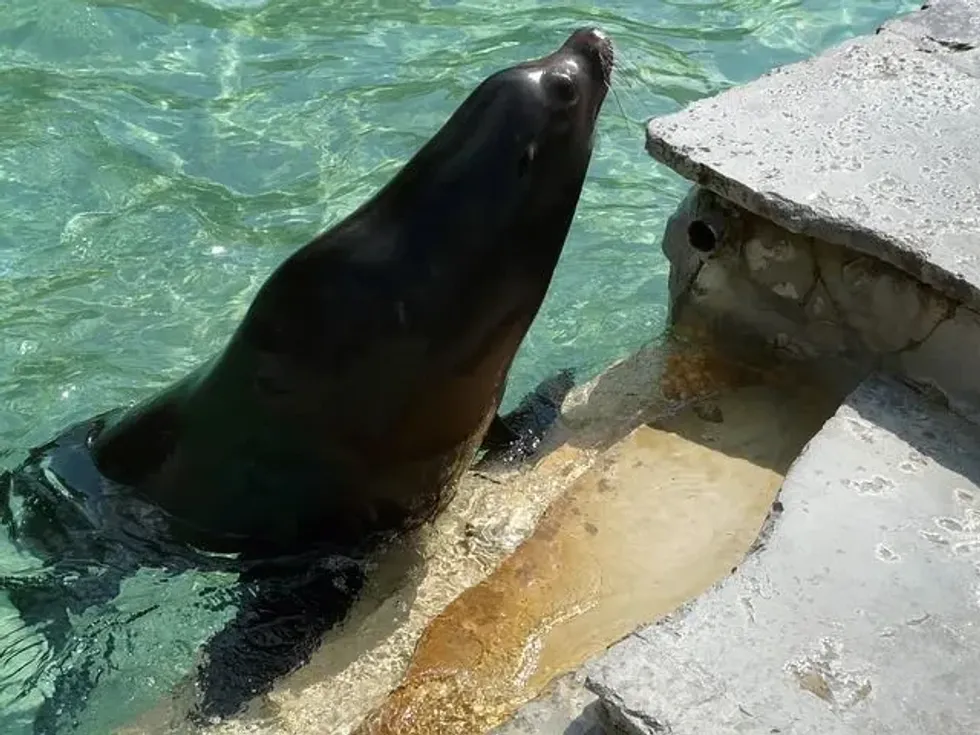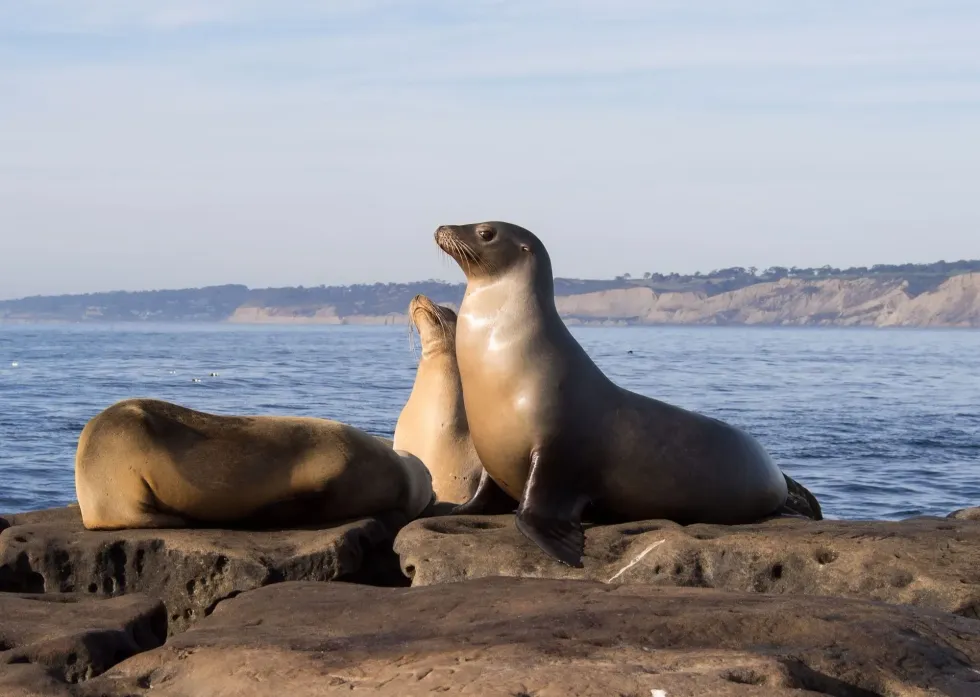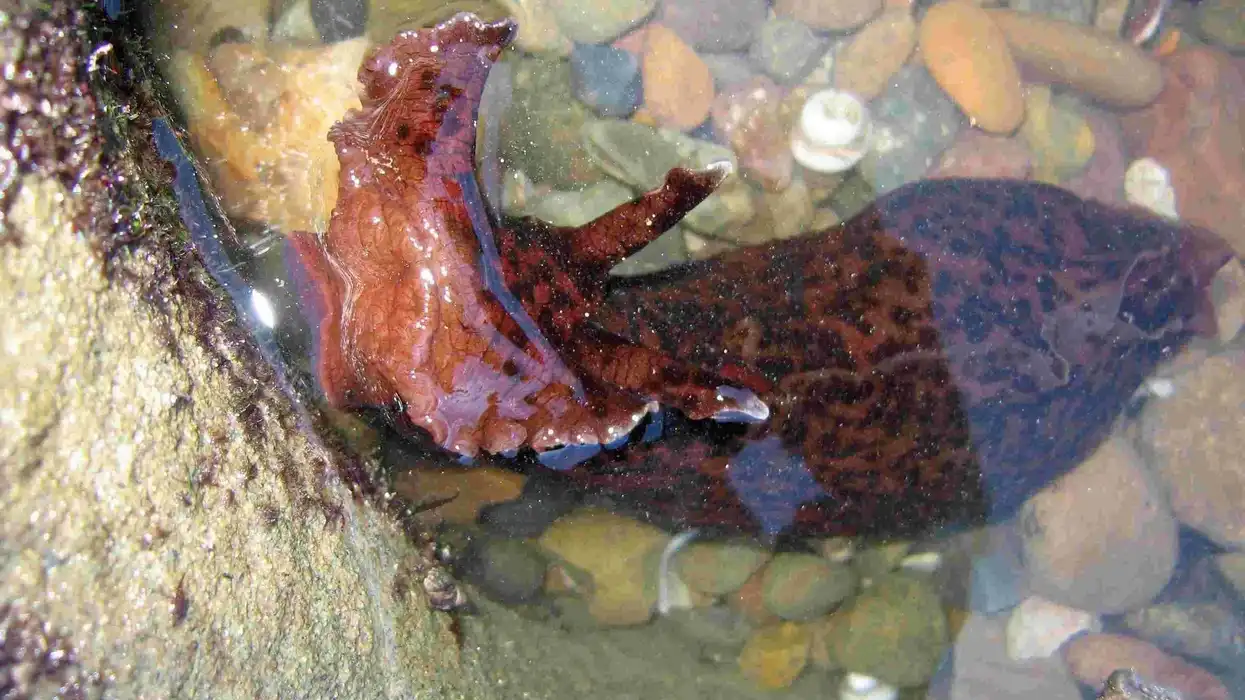Fun California Sea Lion Facts For Kids

The California sea lion (scientific name: Zalophus californianus) is a species of coastal eared seal native to the western coast of North America.
Eared seals are members of the Otariidae family of marine mammals such as seals, manatees, whales, polar bears, and sea otters. They comprise about 15 extant species divided into seven genera and are commonly known as the fur seals or sea lions.
Eared seals differ from true seals and walruses and have a semiaquatic lifestyle, resting and breeding on land or ice while migrating and feeding in the water.
California sea lions reside in coastal waters and on docks, beaches, jetties, and buoys. They mostly feed in offshore areas and are strict carnivores, thriving on a diet comprising various aquatic animals such as anchovies, squids, rockfish, mackerels, and sardines.
Juveniles and adult females are slender-bodied and are usually blonde or tan in color. On the other hand, the adult male California sea lions are dark brown to black and larger than their female counterparts.
Interestingly, they look nothing like lions and have flippers to help them propel through water! What's more, these mammals are extremely intelligent and playful, with trained individuals kept for public display at circuses, zoos, and oceanariums.
The California sea lion population is large enough to afford the species the status of Least Concern in the IUCN Red List. It is protected under the Marine Mammal Protection Act, 1972.
Read on for more such fun and interesting facts about the California sea lions!
If you like what you read, do check out fun facts and information about other mammals, such as the kiang and takin.
California Sea Lion Interesting Facts
What type of animal is a California sea lion?
California sea lion (Zalophus californianus) is a species of the eared seal of the Otariidae family. It belongs to the group of marine mammals called pinnipeds which means flipper-footed. The animal has a semi-aquatic lifestyle and spends time both on land and in the water.
What class of animal does a California sea lion belong to?
California sea lions belong to the class of mammals.
How many California sea lions are there in the world?
According to the Marine Mammal Center, the California sea lion population is estimated to be about 257,000 individuals, with a steadily growing population trend.
Where does a California sea lion live?
California sea lions are native to the western coast of North America, more like the eastern North Pacific Ocean. The range of these sea lions extends from southeast Alaska to central Mexico's Pacific coast, with the breeding locations stretching from southern California's Channel Islands to central Mexico.
As far as the California sea lion migration is concerned, the male California sea lions are known to undertake winter journeys to feeding areas off Oregon, California, British Columbia, Washington, southeast Alaska, and Canada.
Meanwhile, female sea lions and their young ones stay near the breeding colonies until the young are weaned. During El Niño (warm ocean waters), female California sea lions have been reported from Oregon and Washington.
What is a California sea lion's habitat?
Being a coastal mammal, the California sea lion habitat primarily includes coastlines, beaches, and human-made structures such as offshore buoys, piers, jetties, docks, and oil platforms. California sea lions are also kept for public display in zoos and aquariums.
Who do California sea lions live with?
California sea lions are one of the most gregarious marine mammals. These social animals are known to form close-packed groups and rest together on land or float in unison on the water surface in lots called rafts.
They usually are solitary feeders unless there is a large quantity of food available at a site.
When the food supply is more, the animals generally form larger groups while hunting. During the breeding season, female sea lions fight other females to protect their young, and the male California sea lions aggressively defend their territories.
How long does a California sea lion live?
California sea lions have a lifespan of around 20-30 years.
How do they reproduce?
The breeding season of the California sea lions spans from late June to early August, with peaks during early July. The young sea lions, known as pups, are usually born between May and June. The animals tend to breed on remote beaches or islands, with males occupying territory and attacking any invaders.
Vocalizations and aggressive physical displays characterize their defensive behavior. Moreover, the males are polygynous, that is, they have multiple mating partners. A single male's breeding territory may consist of up to 14 females.
California sea lions reach sexual maturity between four to five years of age and begin occupying territories when they are about 9-12 years old. The gestation period lasts for around 11 months, with one offspring born to a single female.
After the pups are born, the mothers nurse them for one or two days and leave them ashore while traveling to the sea for feeding. Then, after a feeding period of two to five days, the mothers return ashore and resume nursing activities.
Interestingly, the pups go without eating while their mothers are absent. The alternate feeding and nesting episodes continue for about a year until the pups are weaned.
What is their conservation status?
As per the International Union for Conservation of Nature (IUCN) Red List of Threatened Species, the California sea lion is a species of Least Concern. It is protected under the Marine Mammal Protection Act throughout its range.
California Sea Lion Fun Facts
What do California sea lions look like?
Adult California sea males range in color from dark brown to black. On the contrary, their female counterparts are blonde or tan-colored.
The pups are dark brown when they are born, but as they reach around four to five months of age, they molt their dark brown coat to assume a lighter brown or silvery coat. Males are larger than their female counterparts.
In addition, the California sea lions have long and narrow snouts with tufts of whiskers. The front flippers are broad, the hind flippers have three to five claws, and the ear flaps are very prominent.
Moreover, the back flippers have a coating of short, black stubble. Another physical characteristic of adult and subadult males is the presence of a distinct forehead crest crowned with clumps of blonde or light-colored hair.

How cute are they?
California sea lions are very cute and adorable. In fact, their snout and whiskers would easily remind one of a dog. Besides, the sea lion's playful nature makes them all the more charming and endearing.
How do they communicate?
California sea lions are loud and vocal animals. Males give out dog-like barks to communicate with females and other males.
On the contrary, the pups and females have scents and vocalizations that are unique to the individuals. In fact, females can recognize their young among hundred of others simply by the pup's vocalization. As a final check, the mothers smell the pup to confirm it is theirs.
The pups, in turn, learn to recognize the vocalizations and scents of their mothers. Like many other marine mammals, California sea lions use echolocation to navigate underwater and locate food.
How big is a California sea lion?
California sea lions are a few feet smaller than leopard seals. While males are about 7.5 ft (2.2 m) long, the female measures around 6 ft (1.8 m) in length.
How fast can a California sea lion run?
An estimate of the California sea lion's running speed is not available. However, these animals are known to be the fastest swimmers of all seals and sea lions and reach maximum swimming speeds of 25 mph (40.2 kph). They can even stay underwater for up to 10 minutes in search of prey.
How much does a California sea lion weigh?
Female California sea lions weigh approximately 24o lb (108.8 kg). Males are at least three to four times larger than females, with an average body weight of about 700 lb (317.5 kg).
What are the male and female names of the species?
Upon attaining sexual maturity at the age of four or five years, male and female sea lions are called bulls and females, respectively.
What would you call a baby California sea lion?
A baby sea lion is called a calf.
What do they eat?
The California sea lion diet is strictly carnivorous and consists of various aquatic organisms. To be specific, their diet includes anchovies, squids, rockfish, mackerels, sardines, Pacific whiting, herrings, salmons, hakes, and octopuses.
The animals are reported to capture fish from sport fishing lines, commercial fishing gear, and fish passage facilities in rivers and dams. When feeding, these sea lions assemble near the mouth of freshwater rivers that guarantee a consistent supply of fish. They are known to feed alongside harbor porpoises, seabirds, and cetaceans.
Are they dangerous?
California sea lions are not normally dangerous. However, they have sharp teeth and are unpredictable wild animals. Thus, it is advised for people not to go too near them, swim with them, or pet them. Also, California sea lions are usually very nervous around humans and tend to run into the water when they smell or spot people.
Would they make a good pet?
California sea lions do not make good pets. While they are generally not aggressive towards humans, their sharp canine teeth can be dangerous if the animal's unpredictable nature makes them violent. Besides, the Marine Mammal Protection Act makes owning California sea lions illegal in the United States. Displaying them in aquariums, zoos, and circuses requires a special permit.
Did you know...
California sea lions were first described in 1828 by French naturalist René Primevère Lesson.
California sea lions are trained by the United States Navy for military operations.
Known predators of California sea lions include killer whales, bull sharks, and great white sharks.
Steller sea lion vs. California sea lion
California sea lions are often confused with Steller sea lions due to their similar appearance. However, the Steller sea lions are lighter in color and much larger. Moreover, unlike the California sea lions, adult male Steller sea lions do not have a prominent forehead crest.
What do California sea lions do?
Of the many eccentricities of the California sea lions, the rafting behavior of the animals is quite unique. During this rafting behavior, the sea lions remain motionless, holding their flippers above the water for a prolonged period.
By doing so, the animals basically rest and regulate their body temperature. Sea lions are also often spotted jumping out of the water, perhaps to speed up their swimming. Breaking waves while surfing is also common.
Here at Kidadl, we have carefully created lots of interesting family-friendly animal facts for everyone to discover! For more relatable content, check out these manatee facts and fox squirrel facts for kids.
You can even occupy yourself at home by coloring in one of our free printable Australian sea lion coloring pages.
Main image by Rhododendrites.
We Want Your Photos!
More for You
See All
Bachelor of Arts specializing in Journalism and Mass Communication, Postgraduate Diploma in Sports Management

Moumita DuttaBachelor of Arts specializing in Journalism and Mass Communication, Postgraduate Diploma in Sports Management
A content writer and editor with a passion for sports, Moumita has honed her skills in producing compelling match reports and stories about sporting heroes. She holds a degree in Journalism and Mass Communication from the Indian Institute of Social Welfare and Business Management, Calcutta University, alongside a postgraduate diploma in Sports Management.
Postgraduate Diploma in Management

Sakshi RaturiPostgraduate Diploma in Management
Sakshi has experience in marketing strategy, social media planning, and recruiting industry experts for capstone projects, she has displayed a commitment to enhancing their skills and knowledge. She has won multiple awards, including a Certificate of Appreciation for Creative Writing and a Certificate of Merit for Immaculate Turut, and is always seeking new opportunities to grow and develop.
Disclaimer
1) Kidadl is independent and to make our service free to you the reader we are supported by advertising. We hope you love our recommendations for products and services! What we suggest is selected independently by the Kidadl team. If you purchase using the Buy Now button we may earn a small commission. This does not influence our choices. Prices are correct and items are available at the time the article was published but we cannot guarantee that on the time of reading. Please note that Kidadl is a participant in the Amazon Services LLC Associates Program, an affiliate advertising program designed to provide a means for sites to earn advertising fees by advertising and linking to Amazon. We also link to other websites, but are not responsible for their content.
2) At Kidadl, we strive to recommend the very best activities and events. We will always aim to give you accurate information at the date of publication - however, information does change, so it’s important you do your own research, double-check and make the decision that is right for your family. We recognise that not all activities and ideas are appropriate for all children and families or in all circumstances. Our recommended activities are based on age but these are a guide. We recommend that these ideas are used as inspiration, that ideas are undertaken with appropriate adult supervision, and that each adult uses their own discretion and knowledge of their children to consider the safety and suitability. Kidadl cannot accept liability for the execution of these ideas, and parental supervision is advised at all times, as safety is paramount. Anyone using the information provided by Kidadl does so at their own risk and we can not accept liability if things go wrong.
3) Because we are an educational resource, we have quotes and facts about a range of historical and modern figures. We do not endorse the actions of or rhetoric of all the people included in these collections, but we think they are important for growing minds to learn about under the guidance of parents or guardians.







